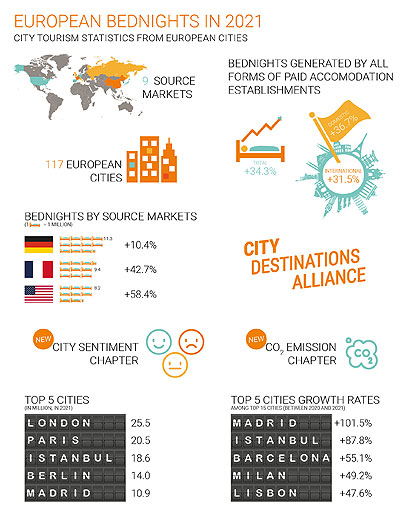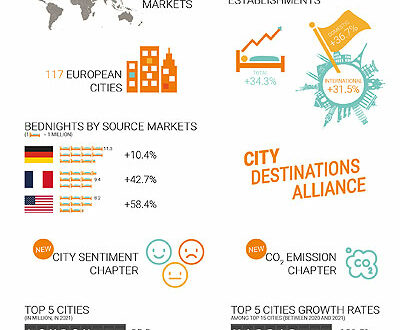[ad_1]
COVID-19 pandemic continued to disrupt tourism industry in 2021, although to a lesser extent than in 2020. CityDNA Benchmarking Report determined that the cities included in the report achieved an average growth rate of 36.7%, which is opposite from the previous year’s rate of -60.9%.
The 18th edition of the City Destinations Alliance Benchmarking Report (=CityDNA Benchmarking Report) includes 117 European cities and features key figures as well as non-tangible KPIs for the year 2021. This development is due to recovery in total bednights experienced in 103 out of 117 analyzed cities. The top three cities in terms of total bednights in 2021 were London, Paris, and Istanbul. Among the top 15 performers, the most notable increases were recorded in Istanbul (87.8%), Madrid (101.5%) and Barcelona (55.1%), which led to an improvement in their rankings from 2020: Istanbul moved from being ranked 4th to 3rd, Madrid from 10th to 5th, and Barcelona from 14th to 9th!
A heterogeneous recovery of Europe’s main source markets
The UK (-26.1%), Russia (-41.3%), China (-37.8), and Japan (-68.5%) continued to record decreases, whereas the remaining top five source markets had increases, anywhere from 10.4% (Germany) to 58.4% (the USA).
 City Tourism is on the recovery path
City Tourism is on the recovery path
The past year has shown positive average annual growth rates in international bednights in both the CityDNA Report cities (31.5%) and the EU 27 nations and UK (12.3%). Cities increased more than other regions (34.3% versus 11.4%) in terms of total bednight volumes, which highlights the importance of city destinations in the European tourism.
“These results demonstrate that in spite of the immense impact of the pandemic over the past two years, European city tourism is on the recovery path. Taking into account the performance in pre-pandemic (2019) and pandemic (2020 and 2021) years, cities are now able to set more realistic targets for recovery of tourism not only in the current year but also in the medium-term. This is where the CityDNA Report comes in!” comments Magnus Hessbo, Chairman of CityDNA Research & Insights Knowledge Group.
Further analyses revealed that the average growth rate of bed capacity for CityDNA Report cities gained momentum with an increase of 12.0% in 2021. Regarding the bed occupancy, the benchmark average in 2021 was 26.4%, in comparison to 21.3% in 2020.
A growing concern about the impact of DMOs’ sustainability strategies and reputation
CityDNA Benchmarking Report also unfolds a new chapter on estimation of transport-related CO2 emissions caused by city tourism, in cooperation with Modul University Vienna. In addition, upon inspection of CO2 emissions caused by tourists traveling to/from the city, average nominal value for total CO2 in 2021 was at 207,616, which was heavily skewed by Madrid, Lisbon, and Amsterdam.
“The choice of destinations is influenced by tourism and non-tourism external factors: geopolitics, climate, health context, social environment and “ghost” ambassadors fueling a positive or negative image of the city and often escaping usual DMOs’ “radars”. This now forms another new chapter of our CityDNA Report, thanks to the social listening-based standard methodology developed by TCI Research.
It is essential to track not only quantitative figures but also the reputation “at large” of cities. Cities are melting pots for our society; they are our home and also the gateway to other cities and regions. The majority of people feel emotionally connected to their city and they are proud of what makes it unique.” concludes Petra Stušek President of CityDNA.
You can read more of the news on source
 Travelsmart
Travelsmart



